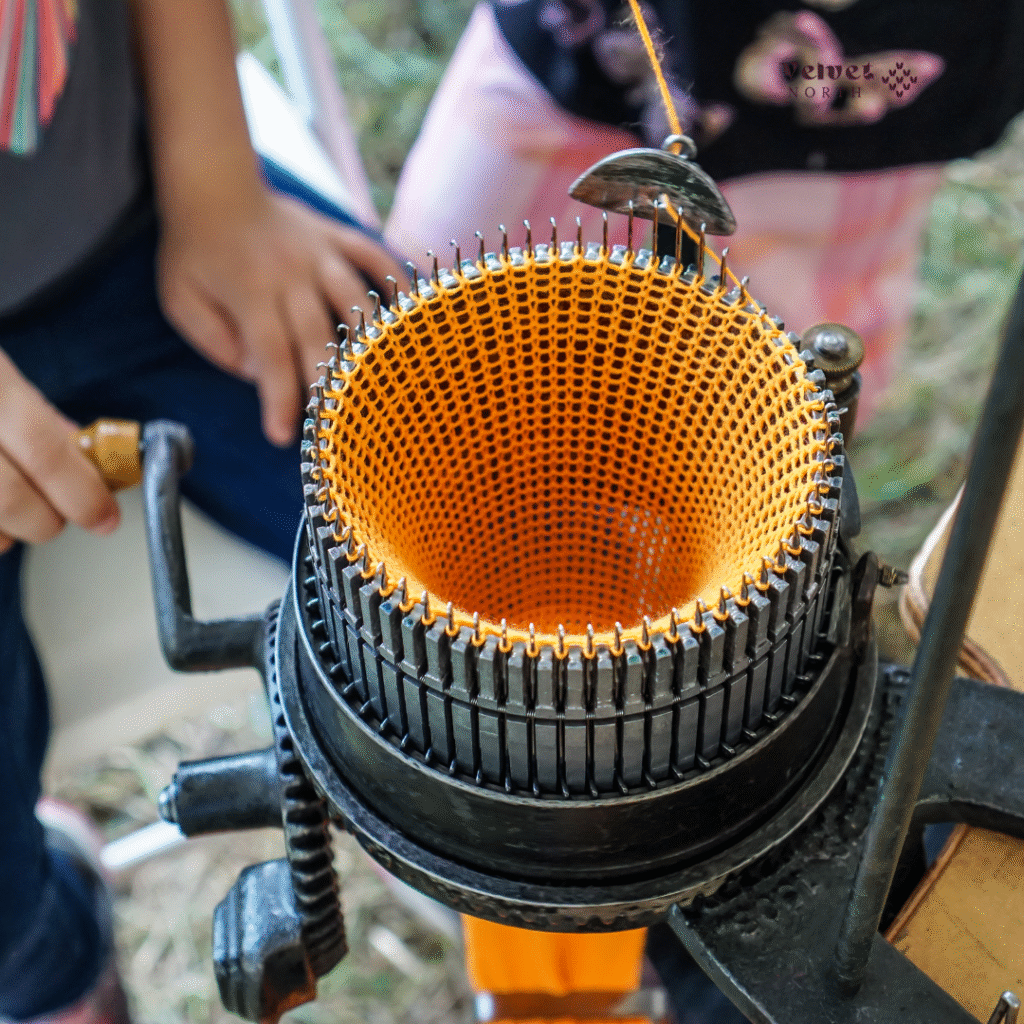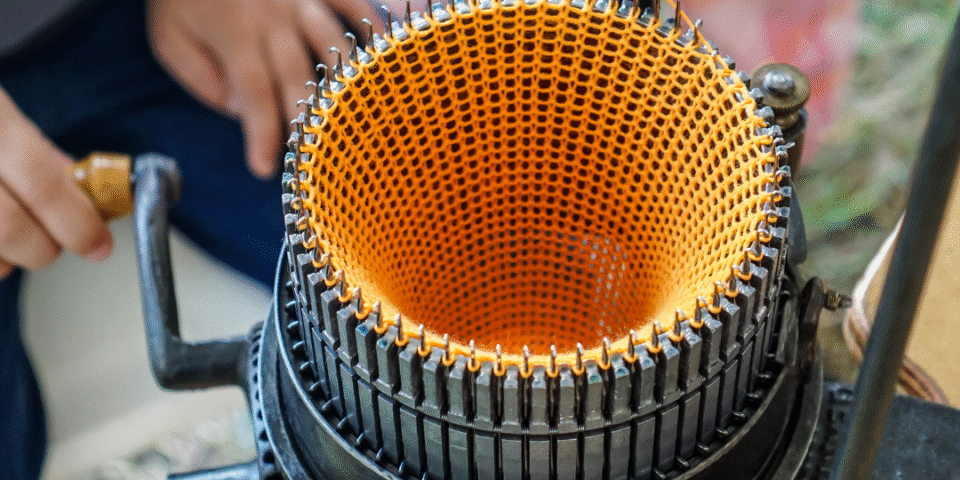A sock knitting machine is a specialized piece of equipment designed to automate the process of knitting socks. While hand knitting can take many hours to complete a single pair, these machines can produce a sock in a fraction of the time, often in less than an hour for home machines and even faster for commercial models. They’ve revolutionized both industrial sock manufacturing and the home crafting market, allowing hobbyists and small businesses to create high-quality, custom socks with speed and efficiency.
How Sock Knitting Machines Work
At its core, a sock knitting machine operates on the principle of circular knitting. A series of needles are arranged in a cylinder, and as the cylinder rotates, the needles move up and down to form loops of yarn, creating a continuous tube of fabric. This seamless tubular knit is what forms the leg and foot of the sock.
The process is a blend of mechanical precision and, in modern machines, computerized control. Here’s a breakdown of the key steps:
- Yarn Feeding: The process begins with yarn being fed from a cone or spool through a tensioner and a yarn feeder. This ensures a consistent and controlled flow of yarn to the needles.
- Knitting the Tube: The machine’s cylinder rotates, and the needles work in a synchronized motion to form the stitches. The number of needles in the cylinder determines the gauge and diameter of the sock. For example, a machine with 84 needles might produce a thicker sock, while one with 200 needles can create a very fine, thin sock.
- Shaping the Heel and Toe: This is where the magic happens. The machine is programmed to knit a heel and toe by using a technique called “short rows.” By automatically raising and lowering specific needles, the machine knits back and forth on a portion of the needles, creating the pocket for the heel or the tapered shape of the toe. This is a complex process that takes years to master by hand, but the machine handles it flawlessly.
- Finishing: Once the sock is knitted, it’s removed from the machine. Depending on the machine and the project, the user may still need to perform some finishing touches, such as closing the toe seam or weaving in loose ends.
Types of Sock Knitting Machines
Sock knitting machines can be categorized based on their level of automation and power source. The choice of machine depends largely on your knitting goals, budget, and desired skill level.
1. Manual Sock Knitting Machines
These are also known as hand-cranked or circular sock machines (CSMs). They are a favorite among hobbyists and are the modern descendants of machines from the late 19th century.
- Pros: They are a more affordable entry point into machine knitting, are portable, and give the user a very direct, hands-on connection to the knitting process.
- Cons: The knitting speed depends entirely on the user’s cranking speed. It can be physically demanding for some, and creating intricate patterns requires practice and manual adjustments.
- Best For: Enthusiasts who enjoy the mechanical process and want to create unique, high-quality socks for personal use or for gifts.
2. Electric and Computerized Machines
These machines are designed for higher efficiency, consistency, and a wider range of design possibilities.
- Pros: They can produce socks at a much faster rate, with some industrial models making hundreds of pairs per day. Computerized machines allow for complex jacquard patterns and precise control over every stitch.
- Cons: They are significantly more expensive and often require a greater technical understanding to operate and maintain. They are less suitable for small-scale hobbyists.
- Best For: Small businesses, designers, or manufacturers who need to produce a large volume of socks with consistent quality and intricate designs.
Leading Manufacturers and Popular Models
The world of sock knitting machines includes both historical names and modern innovators, offering a range of machines for different needs.
- Addi: Known for their hand-cranked knitting machines like the Addi Express King Size, which, while not a dedicated sock machine, can be used to knit seamless tubes for socks. They’re a popular choice for crafters who want to explore machine knitting without a steep learning curve.
- SENTRO: These machines, like the SENTRO 48 Needle Knitting Machine, are widely popular with beginners and hobbyists. They are more affordable and, while simpler in design, can produce tube-like items, including socks.
- Erlbacher Gearhart Knitting Machines: Representing the modern evolution of traditional CSMs, these American-made machines are highly sought after by serious hobbyists for their durability, quality, and community support.
- Lonati and Busi Giovanni: These are major players in the industrial world, known for their high-speed, fully computerized sock knitting machines used in factories worldwide.
A sock knitting machine is a fascinating tool that bridges the gap between traditional handcrafts and modern technology. Whether you’re a knitter looking to speed up your projects or a business owner aiming for mass production, there’s a machine out there to meet your specific needs.
A Brief History of the Sock Knitting Machine
While modern sock knitting machines are a marvel of engineering, their origins trace back to the very dawn of machine knitting. The first knitting frame was invented in 1589 by William Lee in England, a groundbreaking invention that could knit fabric far faster than a person could by hand. Over the centuries, this technology evolved, and by the late 19th and early 20th centuries, hand-cranked circular sock machines became incredibly popular for home use. These machines allowed families to quickly and efficiently produce their own socks and other knitwear, becoming a common fixture in homes during the World Wars. Today, dedicated enthusiasts restore and use these vintage machines, while modern versions offer an accessible entry point to a timeless craft.
Getting Started: What You Need and What to Expect
If you’re considering a sock knitting machine, it’s helpful to know what the learning process entails. While the machine automates the physical stitch formation, there’s a definite learning curve to master the settings, tension, and finishing work.
- Essential Tools: Beyond the machine itself, you’ll need several key items. A yarn winder is crucial for preparing your yarn into neat cakes that feed evenly. You’ll also want to have stitch markers, a darning needle, and a stitch counter. These tools will make your life much easier as you learn the ropes.
- Yarn Selection: Not all yarn is created equal when it comes to machine knitting. For best results, it’s recommended to use smooth, consistent yarns. Avoid overly textured or slubby yarns, as they can cause the machine’s needles to jam. A good starting point is a smooth, sock-weight yarn (fingering weight) that is a blend of wool and nylon for durability.
- The Learning Curve: Learning to use a machine can be challenging at first, particularly mastering the correct tension. It’s not uncommon to drop stitches or have the needles get stuck. Don’t be discouraged! There are countless online forums and video tutorials created by experienced machine knitters. For advice on getting started and to connect with other machine knitters, you can find a dedicated community on Ravelry and its forums for machine knitters.
Beyond Socks: The Versatility of the Machine
While they’re called “sock knitting machines,” these clever devices are surprisingly versatile. Their ability to create seamless tubes of fabric opens up a world of other creative possibilities.
- Hats and Headbands: With a few simple adjustments, you can knit a tube to the desired length, then close off one end to create a perfect beanie or hat.
- Scarves and Cowls: Knit a long tube, then simply bind it off at the end for a cozy, seamless scarf or infinity cowl.
- Sleeves and Garment Parts: You can knit sleeves for a sweater or other garment pieces on the machine, saving you the tedious work of knitting them by hand.
- Small Projects: The machine is fantastic for quick, smaller projects like coffee cozies, wrist warmers, or even small stuffed animals.
- DIY Projects: You can even use the fabric the machine produces for a wide range of other projects. The creative possibilities are endless, and you can find a wealth of free patterns for all sorts of projects on LoveCrafts’ blog.
Maintenance and Troubleshooting
Keeping your machine in good working order is essential for consistent results. Regular maintenance prevents dropped stitches, jammed needles, and other common frustrations.
- Regular Cleaning: After every few projects, it’s a good idea to brush out any lint or yarn fibers that have accumulated in the machine’s cylinder and gears. You can also use a light oil designed for knitting machines to keep the moving parts smooth.
- Tension is Key: Many issues with machine knitting can be traced back to incorrect yarn tension. Experiment with your yarn feeder and tensioning devices to find the perfect balance. If your stitches look uneven or a needle keeps dropping stitches, tension is the first thing to check.
- Troubleshooting: If a needle gets stuck or a stitch drops, don’t force it. Gently use a latch tool or a small hook to work the needle loose or pick up the dropped stitch. Knowing how to troubleshoot these small issues will make your knitting experience much more enjoyable.

The Intersection of Craft and Mindful Living
In a fast-paced world of instant gratification, the rhythmic, meditative process of machine knitting can be a surprisingly calming activity. The whirring of the crank and the steady formation of each stitch can be a form of mindful engagement, allowing you to focus on the present moment. Choosing to craft your own items, whether by hand or with the aid of a machine, is a powerful act of conscious living. It’s a way of pushing back against fast fashion and consumerism by creating something unique and durable. It’s an investment in a skill that not only produces a beautiful finished product but also brings a sense of accomplishment and calm to your daily life. The deliberate act of creating, even with a machine, is an integral part of a life lived with purpose.
Expanding Your Knitting Skills: Beyond the Machine
While a sock knitting machine offers incredible speed and efficiency, it’s not a replacement for the rich and diverse world of hand knitting. In fact, many machine knitters find that the two crafts complement each other beautifully. The machine can handle the repetitive task of knitting the main body of a sock, while you can use your hand-knitting skills to create a beautiful, decorative cuff or a complex heel pattern.
Learning new hand-knitting techniques can add a new dimension to your machine-made projects. For example, while a machine primarily works in stockinette stitch, you could knit a separate cuff in a more intricate pattern, like brioche, and then seamlessly join it to your machine-knit sock. This approach allows you to combine the speed of technology with the artistry of traditional handcraft. Mastering a new skill, whether it’s a complex stitch or a new cast-on method, deepens your connection to the craft and expands your creative possibilities. The focus shifts from just creating a functional item to crafting a piece that is truly unique and personal.
For those looking to challenge themselves and elevate their hand-knitting skills, a technique like brioche knitting offers a rewarding experience. It creates a thick, reversible, and stretchy fabric perfect for scarves, cowls, and other cozy garments. To learn how to master the brioche stitch, you can find a comprehensive guide to knitting this beautiful technique in the continental style on this blog post.If you are interested in exploring the broader principles of a life filled with purpose and intentionality, you can find inspiration and practical advice on the art of slow living by visiting this blog post. The article delves into the idea that simple, thoughtful actions can lead to a more peaceful and fulfilling existence, showing how hobbies like machine knitting can be a part of a larger philosophy.

